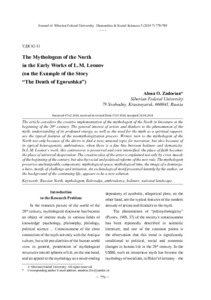Показать сокращенную информацию
The Mythologem of the North in the Early Works of L.M. Leonov (on the Example of the Story “the Death of Egorushka”)
| Автор | Zadorina, Alena O. | en |
| Автор | Задорина, А.О. | ru_RU |
| Дата внесения | 2014-05-20T03:40:39Z | |
| Дата, когда ресурс стал доступен | 2014-05-20T03:40:39Z | |
| Дата публикации | 2014-05 | |
| URI (для ссылок/цитирований) | https://elib.sfu-kras.ru/handle/2311/10362 | |
| Аннотация | The article considers the creative implementation of the mythologem of the North in literature at the beginning of the 20th century. The general interest of artists and thinkers to the phenomenon of the myth, understanding of its profound energy, as well as the need for the myth as a spiritual support, are the typical features of the neomythologization process. Writers turn to the mythologem of the North not only because of the desire to find a new, unusual topic for narration, but also because of its typical heterogeneity, ambivalence, when there is a fine line between holiness and demonicity. In L.M. Leonov’s work, this controversy is preserved and even intensified, the place of faith becomes the place of universal desperation. The creative idea of the artist is explained not only by crisis moods of the beginning of the century, but also by social and political reforms of the new rule. The mythologem preserves unchangeable components: mythological space, mythological time, the image of a demiurge, a hero, motifs of challenge and initiation. An eschatological motif presented latently by the author, on the background of the continuing life, appears to be a new solution | en |
| Аннотация | В статье рассмотрено художественное воплощение мифологемы Севера в литературе начала ХХ века. Общий интерес художников и мыслителей к явлению мифа, осознание его проникновенной энергии, а также потребность в мифе как в духовной опоре – характерные черты процесса неомифологизации. Обращение писателей к мифологеме Севера обусловлено не только желанием найти новую, непривычную тему для повествования, но и характерной ее неоднородностью, амбивалентностью, где между святостью и демоничностью тонкая грань. В произведении Л.М. Леонова эта противоречивость сохраняется и даже усиливается, место веры становится местом вселенского отчаяния. Творческий замысел художника объясним не только кризисными настроениями начала века, но и социально-политическими реформами новой власти. В мифологеме сохраняются неизменные составляющие: мифологическое пространство, мифическое время, образ демиурга, герой, мотивы испытания и инициации. Новым решением оказывается эсхатологический мотив, который автор представляет латентно на фоне продолжающейся жизни | ru_RU |
| Язык | en | en |
| Издатель | Сибирский федеральный университет. Siberian Federal University. | en |
| Является частью серии | Журнал Сибирского федерального университета. Гуманитарные науки. Journal of Siberian Federal University. Humanities & Social Sciences;2014 7 (5) | en |
| Тема | Russian North | en |
| Тема | mythologem | en |
| Тема | Belovodye | en |
| Тема | ambivalence | en |
| Тема | holiness | en |
| Тема | national landscape | en |
| Тема | Русский Север | ru_RU |
| Тема | мифологема | ru_RU |
| Тема | Беловодье | ru_RU |
| Тема | амбивалентность | ru_RU |
| Тема | святость | ru_RU |
| Тема | национальный пейзаж | ru_RU |
| Название | The Mythologem of the North in the Early Works of L.M. Leonov (on the Example of the Story “the Death of Egorushka”) | en |
| Альтернативное название | Мифологема севера в раннем творчестве Л.М. Леонова (на примере рассказа «Гибель Егорушки») | ru_RU |
| Тип | Journal Article | |
| Тип | Published Journal Article | |
| Контакты автора | Zadorina, Alena O.:Siberian Federal University 79 Svobodny, Krasnoyarsk, 660041, Russia; E-mail: amaltea-20x@yandex.ru | en |
| Контакты автора | Задорина, А.О.:Сибирский федеральный университет Россия, 660041, Красноярск, пр. Свободный, 79 | ru_RU |
| Страницы | 778-789 |

